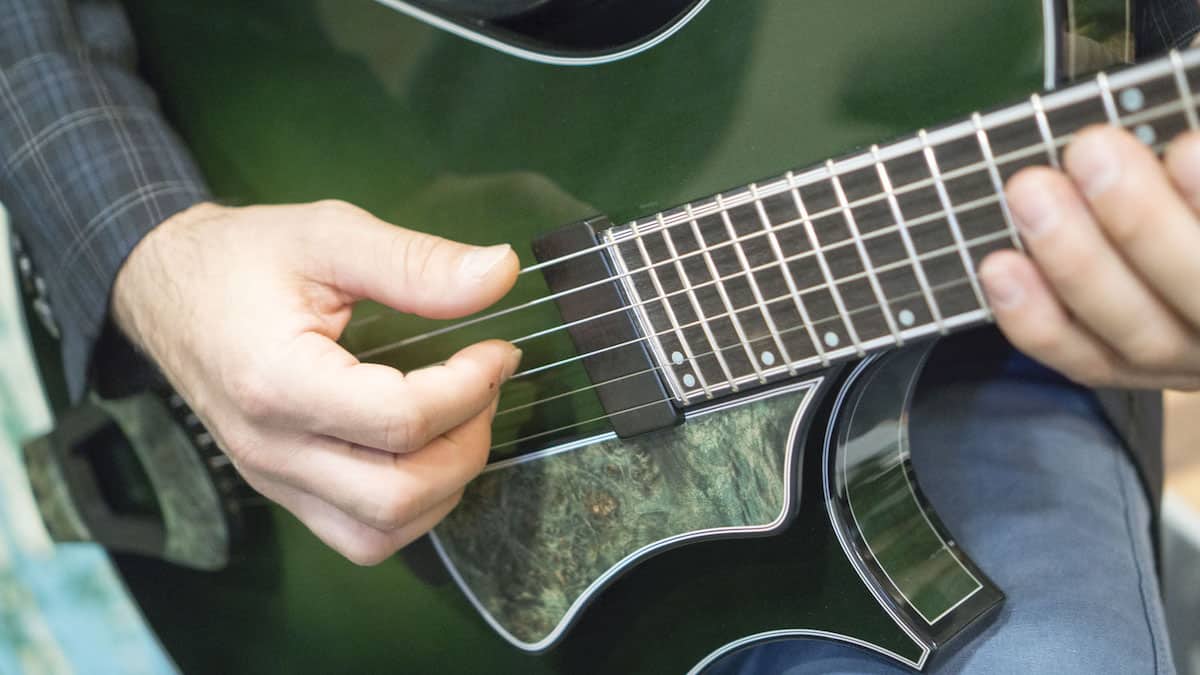Columns
Scales, Arpeggios, Chord Tones???

Bill Farrish addresses the age-old question of ‘what modes and scales’ to use…and when.
If you follow the online forums you’ll find a question that always pops up with someone asking ‘what mode works over what chord’, or ‘what scale should I use for so and so chord’? Usually followed by a bunch of well-meaning replies scolding the person asking the question for even thinking of using modes in the first place. Followed bt the stern warning of if you’re playing modes you’ll never be able to play jazz, etc, etc.
Let’s examine the differences:
Below we have a C Lydian mode next to a Cmaj7 arpeggio built all the way up to the 13th. Followed by a Cmaj7 chord again built all the way up to the 13th.
Hmmm… that’s intersting. They all have the same notes. Yet procalim the use of one over the other and you’ve prety much started an internet guitar war.
Truth be told, all three are EXACTLY the same thing. It’s all just a matter of perspective.
If we were to examine our Cmaj7 chord and really get down to what makes it happen, we’re left with 2 notes.

The 3rd and 7th of any chord are the two notes that define the chord. The root in a typical playing situation is the bassist gig. I’m responsible for the 3rd, the 7th and any color tones either dictated by the melody or the soloist. In our first example, we see that all three choices pull notes from C Lydian, the Cmaj13 Arp and the Cmaj13 Chord – ALL HAVE THE SAME NOTES. So what difference does it make where I choose to get my notes from when improvising? The truth is, IT MAKES NO DIFFERENCE WHAT – SO – EVER.
As long as you are grounded in the harmony (chord movement) of the song it makes no difference. It all comes down to personal choice and what makes it easier for you to see things and navigate the changes and really. They are just different ways of looking at the same exact thing. And truth is you need it all.
Instead of wasting time arguing over which is the “right thing” to use when playing over changes, your time would be much better spent studying how harmony works, and how chords are related and connected. All, useable scales and
That’s it, straight up. AND THERE”S A LOT IN THERE TO EXPLORE.
Here’s how I see a basic CMaj7 Chord and what I mean by there’s a lot in there. The reason I say ‘basic’ is because I’m not including other variations of the chord ie: Maj7(#5).
Every one of these Pentatonic scales and Arps exist inside of the CMaj13 chord. The Arps in both Triad and 4 part chord form (be careful when using the 4 note Arps in terms of context – the triad version of each is easier to begin working with)
If I choose to include chromatic tones (leading tones) into the chord tones of my basic CMaj7 chord.
IT’S ALL THE SAME THING!

Does this mean that whenever a Cmaj7 chord pops up I can just run a chromatic scale as some would lead you to believe? No absolutely not. I have to take into consideration, where the chord is going to, and what the melodic line I’m creating is refelcting before that chord came up. Not to mention the style the song is being performed in. But it does mean is that within my CMaj7 chord I have wide range of colors to choose from to fit the situation.
No matter how you slice it, whether you choose to learn arps or modes, it’s all the same notes. Just a different way of seeing the same thing. Your job is to find the way that works for you and continue larning and growing. My best advice is also study harmony and melody, because when push comes to shove, that’s all there really is.
What works for me and what I teach, is ‘Think Harmonically’, in the correct context of the music you are working with.
All of the stuff I’ve just laid out in this article is just CMaj. Like everyone else when I first started learning I saw all of this as different scales and arps. After all the practice and grunt work now it’s just all the same thing to me. With a little bit of effort, the same will happen for you. Start out slowly, loop one chord pick two sounds you like and go for it. Then add another chord and practice connecting things around the circle of 4th’s and keep on going wth it.
Keep learning and try working this out for every chord you know. Yeah, it’s a lot of work, have fun, keep learning and you’ll find your own way around.
All Lesson Content: © 2019 Bill Farrish/Farrish Music Co. Used by Permission
-
Jazz Guitar Lessons2 weeks ago
New JGT Guitar Lesson: Analyzing “Without A Song”
-
Jazz Guitar Lessons4 weeks ago
New JGT Guitar Lesson: Considering “Falling Grace”
-
Artist Features1 week ago
New Kurt Rosenwinkel JGT Video Podcast – July 2024
-
Artist Features3 weeks ago
JGT Talks To Seattle’s Michael Eskenazi























